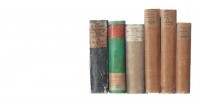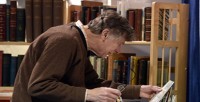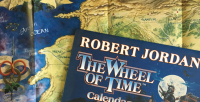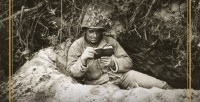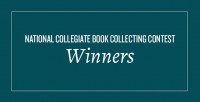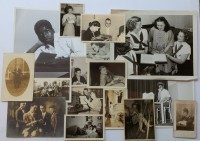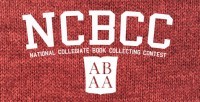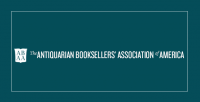Research documenting rare bindery dust jackets from the eighteenth to the twentieth centuries. Adapted from the Spring 2019 Journal of The Private Libraries Association, Pinner, Middlesex, England. Reprinted by permission. The practice of issuing dust jackets on new books is generally thought to have begun with the introduction of publishers' bindings around 1820. Books issued before then (and after) in provisional bindings are believed to have neither needed nor received jackets.1 But while this understanding of early jacket use has long seemed correct for British, American and European books, recently examined evidence shows that dust jackets were issued long before the 1820s in the German states and probably elsewhere in Europe. Most of the surviving examples of these jackets, including the earliest ones, are of German origin, which is where this previously undocumented and all but unknown chapter of book history begins. I. Two-piece bindery jackets 1760s–1860s Throughout the latter decades of the eighteenth century and beyond, German binderies produced a distinctive and durable type of dust jacket for the simple board bindings of that period. This practice continued well into the era of publishers' bindings in the nineteenth century. Examples of these jackets have been examined on about thirty titles, all bound in paper-covered boards, from the 1760s to the 1860s.2 These early jackets had several characteristics that were common to them throughout the entire period of t... [more Early Bindery Dust Jackets]
On Collecting Books
Wouldn't you like to automate the process of searching our members' listings for the books or other items you desire? Well, you can easily let us do the searching for you! WANT LISTS Customers can set up “Want Lists” — saved searches for the books or items you are actively hunting for — which alert you (by email) anytime a new copy is listed or an existing listing changes substantially (new price, image added, etc.). You can tailor the frequency of these emails to suit your needs: Daily emails let you know within hours of any change or new copy being listed. Weekly or monthly emails will send you a digest of all new titles listed in the preceding week or month (and not sold by the time the email is sent). The default setting is for daily emails (as that's what ABAA members prefer). If you're actively trying to collect a popular niche or subject area, you may want more frequent emails, so no other collector beats you to your prize. CREATING A SAVED SEARCH "Want List" searches can be as general or specific as you wish. You can search for any books by a particular author, or just first editions, with or without dust jackets, or a very specific edition within a certain price range, etc., etc. If you want to monitor new listings in a broad category, enter the salient information in the “Keyword” field. (Ex: "Anarchy" or "Poetry, Ireland"). Once you've set up the search parameters, you can sit back and relax in the knowledge that if a book you want is offered for sale o... [more Let Us Do the Rare Book Searching for You!]
Robert Jordan was the best-selling author of The Wheel of Time fantasy series, and (because I need to get my utter impartiality out of the way at the start) one of my favorite authors. I've collected his books for the past 25 years. If you're unfamiliar with The Wheel of Time, think of it as a 14-volume The Lord of the Rings set at a future point in Earth's history when society has regressed technologically and forgotten most of our history -- but discovered magic, naturally! Total sales for the series are estimated to be in excess of 80 million copies, although those figures are several years old and at least one of his publishers has suggested the estimate is on the low side. With a total readership of that magnitude, it seems likely there are many people collecting Jordan's books and related items, so we have assembled this guide to the major works and significant associated items. Jordan's real name was James Oliver Rigney, Jr., a Vietnam veteran who later worked for the US Navy as a nuclear physicist. Rigney began writing for his own amusement in 1977, and published under several pseudonyms in the 1980s. The first book of The Wheel of Time (WoT) series, The Eye of the World, was published in 1990, and sold well. By 1993, when the fifth installment, The Fires of Heaven came out, WoT books were huge bestsellers. Rigney was diagnosed with amyloidosis in 2006, and died in September 2007 after undergoing extensive medical treatment at the Mayo Clinic. After his death, one of ... [more Collecting Robert Jordan’s Wheel of Time]
Armed Services Editions, small-format paperback books distributed to US servicemen during WWII, are credited with achieving a great deal: not just with improving morale among the troops, but also with revolutionizing the post-war publishing industry, making certain books into classics, and expanding the American middle class. The book When Books Went to War: The Stories That Helped Us Win WWII, by Molly Guptill Manning, reveals the largely forgotten story of the Armed Services Editions. When the US entered the war after Pearl Harbor, librarians initially got behind a nationwide book drive, the Victory Book Campaign, which aimed to collect 10 million donated books and supply them to the troops. Although this campaign was eventually successful, it took time, and many of the donated books were too old or heavy to be of use. A group of publishers came together to form the Council on Books in Wartime, and resolved to produce a series of lightweight, durable books which reprinted popular novels and classics that would be of interest to the soldiers, sailors, and airmen serving their country. The format was innovative: paperback, stapled (later glued) on the short side, and printed in small type across two columns to fit more words on a page and make reading under battlefield conditions easier. The covers were thumbnails of the original hardcover jacket image, and carried lists of the other ASE titles released that month. The books were initially printed in two sizes, both designed ... [more Collecting Armed Services Editions]
We asked the winners of the 2021 National Collegiate Book Collecting Contest to introduce themselves, and learned about some fascinating books and collections along the way! First place: Jessica Camille Jordan (Stanford University): Could you give us a brief description of your collection? My collection is comprised of works that bear the illustrative or graphic design work of husband/wife duo Leo and Diane Dillon, whose career together spanned six decades. Most of the objects in my collection are books, but there are also comics, records, posters, and more. The earliest items I have are science fiction pulp magazines from the 1950s, and the most recent is a 2019 picture book called Love and the Rocking Chair, an autobiographical story they were working on at the time of Leo's death in 2012, and which Diane later completed. What first interested you in Leo & Diane Dillon? Although I didn't know it at the time, their artwork graced some of my favorite books as a young reader, including Wise Child by Monica Furlong and Sabriel by Garth Nix. Later on, I learned more about their fascinating lives and career, and I felt it was important to try and create a comprehensive bibliography of their work. But I have always been really drawn to and moved by the beauty of their art, and that's where the initial interest came from. What currently has pride of place in your collection? Probably the Reader's Digest Condensed Books installment that contains their illustrations for a condensed v... [more Meet the 2021 NCBCC Winners]
We are pleased to announce that for the fourth year the Northern and Southern California chapters of the ABAA will be jointly awarding a prize for the best young book collectors in California. As with prior years, three prizes will be awarded, and the top collection will be exhibited at the upcoming 52nd California International Antiquarian Book Fair to be held in Oakland this coming February. Submissions are due December 1, 2021 and winners will be notified by December 20, 2021. Complete details are found here. [more Announcing The Fourth Annual California Young Book Collector’s Prize]
The ABAA is proud to announce the winners of the 2021 National Collegiate Book Collecting Contest. First: Jessica Camille Jordan (Stanford University) for "Six Decades of Leo and Diane Dillon." Second: Read W. Brown (New York University) for "The Serious Business of Fun: A Collection of Books on the Video Game Industry." Third: Shannon D. Bohle (Johns Hopkins) for "Life through Space and Time: A Personal Journey through Modern Science, Collecting Hand-signed Autographs, Manuscripts, and First Editions." Essay Award Joseph E. Hiller (Duke University) for his essay "Como un detective salvaje: Gathering Small Press, Experimental, and Untranslated Latin American Literature." The National Collegiate Book Collecting Contest is jointly administered by the Antiquarian Booksellers' Association of America (ABAA), the Fellowship of American Bibliophilic Societies (FABS), the Grolier Club, and the Center for the Book and the Rare Books and Special Collections Division (the Library of Congress) Congratulations to all the winners of the 2021 National Collegiate Book Collecting Competition! [more 2021 NCBCC Winners]
The 2021 National Collegiate Book Collecting Contest is now accepting entries! Established in 2005 by Fine Books & Collections Magazine to recognize outstanding book collecting efforts by college and university students, the contest is now sponsored by The Antiquarian Booksellers' Association of America (ABAA), the Fellowship of American Bibliophilic Societies (FABS), the Grolier Club, and the Center for the Book and the Rare Books and Special Collections Division of the Library of Congress. The contest aims to encourage young collectors to become accomplished bibliophiles. Book-collecting competitions are held at more than three dozen colleges and universities across the United States, and some of these contests have been conducted for many decades, dating back to Swarthmore College's first competition in the 1920s. All college or university prizewinners are encouraged to enter. Student collectors whose institutions do not offer a book collecting contest may also enter. The contest rules can be viewed here... Applications may be submitted here, and all entries for the 2021 competition must be submitted by June 15, 2021. The Antiquarian Booksellers' Association of America promotes ethical standards and professionalism in the antiquarian book trade, encourages the collecting and preservation of rare books, and supports education and research. The Fellowship of American Bibliographic Societies was formed in 1993 as a national organization of member book collecting groups. The C... [more National Collegiate Book Collecting Contest 2021]
The Antiquarian Booksellers' Benevolent Fund Since its founding in 1952 by a group of ABAA members, the Antiquarian Booksellers' Benevolent Fund has been dedicated throughout its history to providing timely financial assistance to those in the book trade who find themselves in a time of need. Originally known as The Charles Grand Memorial Fund (a founder's reminiscence can be found below), it was specifically meant to provide “for the assistance of needy persons, regardless of affiliation, who are or have been engaged in the business of selling and dealing in books, manuscripts, and printed matter in general,” with the only proviso being that funds may be granted only for personal needs, not for business needs. In a typical year, the Fund gives a total of $40,000 in one-time disbursements to booksellers in need, the majority of whom are not members of the ABAA. Historically, the Fund has been sustained by donations from ABAA members, their generosity born out of their understanding of how precarious a livelihood in the book trade can sometimes be. Most antiquarian booksellers are individual proprietors with limited capital, and are especially vulnerable to unanticipated ill-health, accidents, natural disasters or other types of misfortune. The Antiquarian Booksellers' Benevolent Fund is administered by a group of Trustees comprised of the three most recent Presidents of the ABAA. The ABAA regards its stewardship of the Benevolent Fund as one of its most important responsi... [more Donate to the Benevolent and Woodburn Funds]
Rare books and ephemera can be a fascinating avenue to examine the past and understand what was really happening during significant events or time periods. We took a deep dive into the database to see what light our members offerings could shine on America's new favorite drama... The Queen's Gambit Netflix's #1 new show is the coming-of-age story of a female chess prodigy struggling with addiction and the chauvinism inherent in 1960's American society. Based on Walter Tevis's 1983 novel of the same name, the show is being talked about for many reasons, not the least of which is the way it revels in decidedly analog pleasures -- the slow, methodical game of chess itself and the fashions of the 1960s -- and a very retro style of editing at odds with the frantic pace of modern television. At the same time, its vision of glass ceilings shattering and the importance of a team of like-minded friends to support each other speaks directly to issues very much on our minds at the current moment. Chess lovers have noted the accuracy and care with which the chess games themselves are depicted, which is no surprise considering the show recruited Grand Master Garry Kasparov and noted chess instructor Bruce Pandolfini (who also helped proof-read the original novel!) to oversee the gameplay and coach the actors on the nuances of competitive chess. In this time of social isolation, games like chess are discovering new fans and inspiring older ones to return to the board (the so-called "pandem... [more Behind The Queen’s Gambit]


